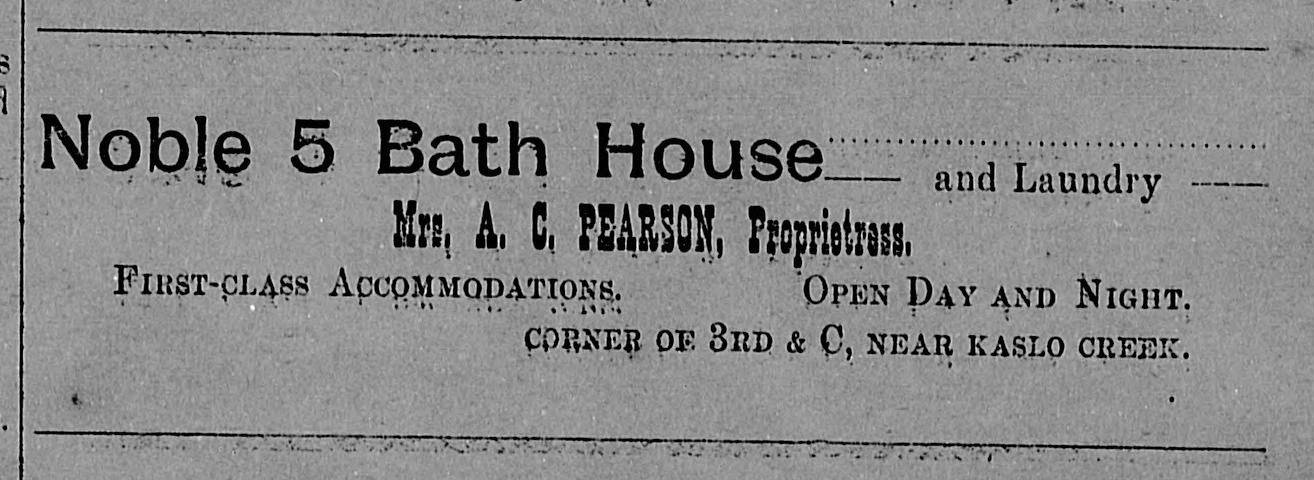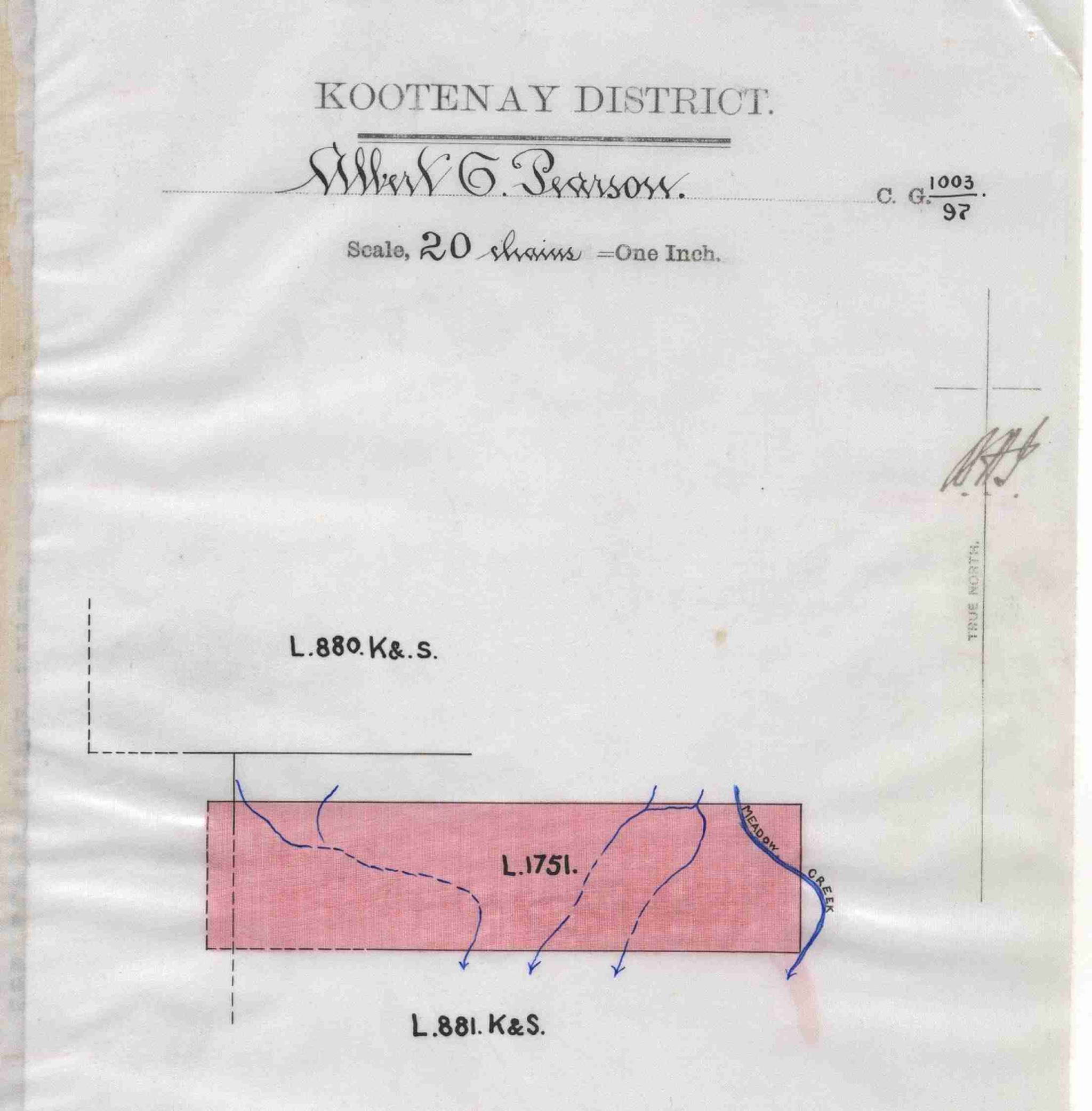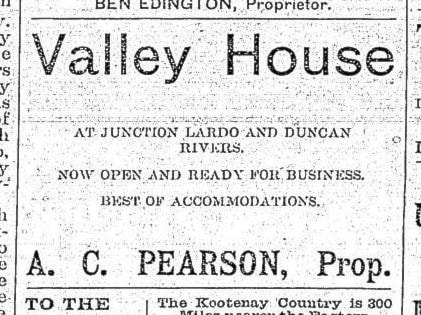Two hundred forty-second in a series on West Kootenay/Boundary place names
Garden Valley was at the junction of the Lardeau and Duncan Rivers where Albert Clarkson (Crazy Horse) Pearson (1855-1914) established a halfway house in 1893.
Pearson, an Indiana native, grew up in Iowa. By 1880, he was a laborer in Rock Creek, Oregon. He first appeared in West Kootenay in late 1891, working on Toad Mountain, home to Nelson’s Silver King mine. The following year he announced plans to start a bakery, laundry, and bathhouse in Kaslo and in March 1893 he applied for a liquor license for an hotel 10 miles above the town of Lardo (now spelled Lardeau), at the site of a sulphur springs along the government trail.
As the Nelson Miner of April 29, 1893 described it: “A.C. Pearson has a fine two-story house about eight miles up the Trout Lake trail, which he is fitting up very comfortably. Those who put up there will receive every accommodation which a wayside hotel of the first order can afford. The structure is very creditable. All the carpenter work has been done in split cedar with a jack plane.”
He called the location Garden Valley, first mentioned in the Kaslo Slocan Examiner on May 13, 1893: “A.C. Pearson came in Tuesday from Garden Valley on the Lardo. He reports that for the first 15 miles on the government trial the snow has entirely disappeared. From the head of Garden Valley to Selkirk, the snow is still about two feet deep.”
(Selkirk is now known as Gerrard.)
The only other mentions of Garden Valley came in the Nelson Tribune of April 14, 1894, which published a series of letters written the previous year by John Retallack, Charles W. McAnn, and William B. Williams. They indicated Garden Valley was otherwise known as Pearson’s, or that Pearson’s was considered a place within Garden Valley.
• “I have the honor to report that at the time of the Duncan excitement, when the river was too swift for travel, prospectors were entering the region via Argenta on one side of the lake and ‘Pearson’s’ on the Lardo, on the other.”
• “The distance from the head of [Kootenay] lake to Pearson’s is 8 or 9 miles, and from Pearson’s to Trout Lake about 30 miles. I do not know the distance from Pearson’s to Duncan City but the distance from Pearson’s to where the trail would cross the Lardo river is about two miles.”
• “The trail was built, or work done on on it, by these men from Garden Valley, at the head of Kootenay lake, to Duncan City.”
• “Last spring, by some hook or crook, a trail was started from Pearson’s, in Garden valley, on Lardo river …”
The hotel soon outlived its necessity. Pearson’s whereabouts aren’t known for the next few years, but his wife ran the Noble Five bath house and laundry at 3rd St. and C Ave. in Kaslo from at least 1895-97.
In 1899, Pearson and Henry Williams started a floating hotel and restaurant on a scow at Kootenay Landing, near the south end of Kootenay Lake. When business slowed, they towed the two tarpaper-covered buildings to Argenta, where they advertised “The Kootenay Landing hotel is the best house to stop at in Argenta” and “The wet grocery department of the Kootenay Landing Hotel at Argenta is away above par.”
However, Pearson was twice fined for selling liquor without a license — $75 for the first offense and $100 for the second, which put them out of business. The partnership dissolved.
In August 1899, Pearson sold his Meadow Creek property to the Vipond family (he only received a Crown grant for it the previous year). Fred Vipond discussed the hotel in his memoir: “On high ground beside the meadow there was a large two-story log house, with floors both upstairs and downstairs and all partitions, tables, and benches of split cedar as well as a shake roof.”
The Viponds reopened the building as a roadhouse for a while, but abandoned it when they moved to Trout Lake in 1902. In Lardeau Duncan Memories, Ernie Alexander (1914-2001) recalls finding it years later in a “thickly wooded draw.”
“It was held up by several large trees which had grown up alongside the walls … The evidence of the hundreds of empty whisky and rum bottles proves that they must have done a roaring business. These bottles were covered over by a foot or more of leaf mold … One small bottle was marked ‘pain killer’ and probably was justly named.”
Pearson enlisted in Nelson for the Second Boer War in 1900 and served with the Strathcona Horse and Canadian Scouts. On his enlistment form he gave his occupation as miner and his next of kin as a daughter in Huletts, New York. He also indicated he had a 16-year-old son and 18-year-old girl who were “not depending on him.”
Wherefore the name Crazy Horse? Journalist Robert T. Lowery explained it in The Ledge of Sept. 19, 1918: “During the Boer War, Crazy Horse Pearson was the biggest coward in the British army. He narrowly escaped being shot several times by officers for stampeding in front of the enemy. He was always nervous and trying to get into the hospital, upon a plea of sickness. He should have stayed in Kaslo …” (In another instance, Lowery accused Pearson of cheating at cards.)
In 1911, Pearson married Nancy A. McWhirter in El Paso, Texas. Two years later he arrived in Winnipeg, “now entirely crippled as the result of his experiences in the Yukon.” There was no word what those experiences were, but he spent several months in hospital and asked the city to pay his $54 bill. He also applied for a land grant given to South African war veterans, who were entitled to 320 acres each.
It’s not known what the outcome of either request was, but Pearson died in Fairbank, Iowa in 1914, age 59.


